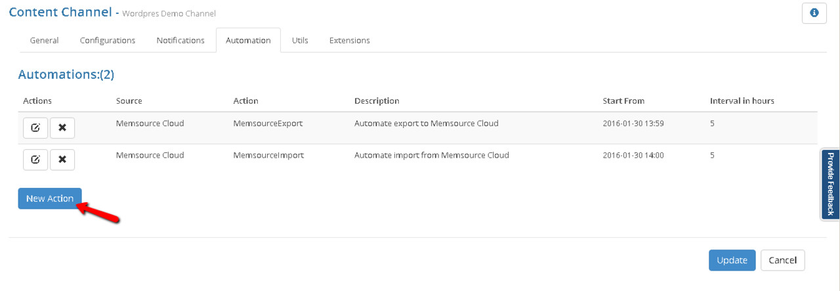With iLangl translation and localization become iLangl integration solutions turn localization into a streamlined process. You Among other features, you can automate import/export of new new or modified CMS content from the CMS. You can perform the following functions with the Automation tool. Automation tool offers the following functionality:
- Automate export to Translation translation tool.
- Automate import from Translation translation tool.
- Set up Data and Time from which content should be trackedthe date and time that will mark the start of content tracking.
- Specify in how many Hours the frequency (in hours) of the automation process should repeat.
- Specify Automatic Export Settingsautomatic export settings.
To set up automatic change tracking of changes Navigate , go to the 'Automation and Notifications' settings pagetab:
- Start from your Go to 'My Channels page'.
- Click on 'Edit current connector' near the 'Automation and Notifications' Page.
3. Now, click on 'Automation' to access the automation system.
4. Click the 'New Action; ' button.
5. The Use the drop-down menu to select the extension in the 'Add Automatic Action' pop-up will open. Now choose the extension from the drop down menuwindow.
6. Now, an In the 'Action' form will open up. From here you can choose to perform Import or Export actionchoose the type of action: export or import.
Specifying
...
Rules for Automatic Export
...
Tracking changes Change tracking is automated by iLangl. To view the when content was last changed time of last content change, refer to Utils.
To set the automation start date and time of automation manually or to perform a automate content export to the Translation tool cloud , please do the following:
- Set Extension to Translation toolChoose respective extension from the drop-down list.
- In Action choose Automate Export to Translation tool'Action' menu, select 'Automate export to translation tool'.
3. To set the start data date and time from which to start of automatic tracking:
- Set the Start Date start date in the format Yearyyyy-Monthmm-Daydd format. You can also choose the date from the enter it manually or use the calendar.
- Set the time by scrolling through the hours and minutes. You can also enter the time manually.
4. Select the number of hours after which iLangL Cloud should check for new content.defining the frequency of content check.
Editing Automatic Export
...
Settings
Using With this function the feature, you can set which select a particular language pair you'd like to track,.
- To set the a language iLangl should track, choose the language from the 'Source Language language' drop-down menu. To export you can choose toNext, choose the export option that meets your needs:
a. Create a 'New Project' - always export content as a new project. Choose a CMS template from the 'Project Template' drop-down menu.
b. Use 'Existing Project' - always export content to an already existing project. Choose an existing project from the 'Project' drop-down menu. - To choose the language to which the content has to be exported to, from the Use 'Target Languages' drop-down menu , to choose the target language.
Note: More than one target language for export can be added. To do this click the Click 'Add Language button'. Now, select languages from the drop down menu.Click OK ' button to add more target languages. - Click 'OK' to save.
Specifying
...
Rules for Automatic Import
...
To set the automation start date and time of automation manually or to perform a automate content import from the Translation tool , please do the following::
- Set Extension to Translation toolChoose respective extension from the drop-down list.
- In Action choose Automate Import from Translation tool'Action' menu, select 'Automate import to translation tool'.
- To set the start data date and time from which to start of automatic tracking:
- Set the Start Date start date in the format Yearyyyy-Monthmm-Daydd format. You can also choose the date from the enter it manually or use the calendar.
- Set the time by scrolling through the hours and minutes. You can also enter the time manually.
Editing Automatic Import
ActionSettings
The status of the translation is visible desired workflow can be defined under the 'Automatic Import Settings'.
- Using the Workflow Step drop down menu you can set the job status as 'Translation', 'Revision', or 'Client Review'.
- Using the Job Status drop down menu you can set the job status as 'Assigned', 'Completed', 'Completed_by_Translator', 'Declined_by_Translator', 'Emailed' or 'New'.
- To import and publish the translation from Translation tool to the CMS place a check near Import and Publish.
- To choose the language to which the content has to be imported to, from the 'Target Languages' drop down menu, choose the 'Workflow step' - choose a respective workflow step (e.g. translation, revision or client review) from the drop-down menu.
- 'Job Status' - define a job status that will trigger the import (e.g. assigned, completed, completed by linguist, declined by linguist, emailed or new).
- If you want the imported content to be published automatically upon delivery, please check 'Import and Publish' box.
- Use 'Target Languages' drop-down menu to choose the target language.
Note: More More than one target language for export can be added. To do this click the Click 'Add Language' button '. Now, select languages from the drop down men Click OK to saveto add more target languages. - Click 'OK' to save.
| Info |
|---|
Related articles
| Filter by label | ||||||||||||||||||
|---|---|---|---|---|---|---|---|---|---|---|---|---|---|---|---|---|---|---|
|
...


